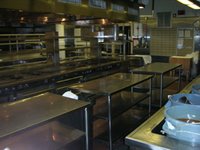EXPEDITING: SAUCIER 1ST ROUND
 We're at a new station (Saucier) in the kitchen, cooking a meat entree for the restaurant for the first time. Monday's menu calls for Chicken Leg Braised With Forty Cloves of Garlic (Provence), Cuisse De Poulet Braisee Aux Quarante Gousses D'Ail. Forty cloves of garlic!
We're at a new station (Saucier) in the kitchen, cooking a meat entree for the restaurant for the first time. Monday's menu calls for Chicken Leg Braised With Forty Cloves of Garlic (Provence), Cuisse De Poulet Braisee Aux Quarante Gousses D'Ail. Forty cloves of garlic!DISH: Chicken Leg Braised With Forty Cloves of Garlic (Provence), Cuisse De Poulet Braisee Aux Quarante Gousses D'Ail
 RECIPE: Preheat oven to 375F. Melt 25g butter and 25ml oil on high heat and brown legs on all sides then remove. In remaining fat and oil saute mirepoix of 2 medium onions and two celery stalks. Remove vegetables, degrease then deglaze pan with 125ml white wine. Season chicken with salt and pepper, place in roasting pan over vegetables, add deglazed white wine and sprinkle nutmeg on top. Separate forty cloves and tuck them under the chicken with the vegetables. Cover pan, place in the oven and braise for 1 1/2 hours, turning chicken at least once (above right, Saucier).
RECIPE: Preheat oven to 375F. Melt 25g butter and 25ml oil on high heat and brown legs on all sides then remove. In remaining fat and oil saute mirepoix of 2 medium onions and two celery stalks. Remove vegetables, degrease then deglaze pan with 125ml white wine. Season chicken with salt and pepper, place in roasting pan over vegetables, add deglazed white wine and sprinkle nutmeg on top. Separate forty cloves and tuck them under the chicken with the vegetables. Cover pan, place in the oven and braise for 1 1/2 hours, turning chicken at least once (above right, Saucier).Separate legs and manchonnez drumsticks (remove thighbone), toss mirepoix, then strain and degrease braising liquid and serve with vegetable of choice. Accompany with croutons made from baguette sliced on a bias in 16 pieces on which to squeeze roasted garlic.
BREAKDOWN: I helped with the prep work but when it came time to cook the chef chose me as our representative at the front of the kitchen to do expediting (acting as the liason between the front of the house, the waitstaff, and the back of the house, the cooks) for the fish station (Poissonier). I was a bit nervous but I'd also been looking forward to learning how to do expedite.
In school we use two dry-erase boards near the front of the kitchen near the doors to the restaurant. This isn't done in most restaurants, it's just a system created to help us learn how to keep track of orders and food production. There are several columns on the dry-eraseboard: Tables, Covers, Dish #1, Dish #2, Tables, Covers, Dish #1, Dish #2. The restaurant serves a five-course tasting menu with two alternatives for each course. Level Four cooks the first option for each station and Level Three cooks the second alternative for each.
Here's how it works: the entire order for each table is printed on receipts on a table at the front of the restaurant. There's a white copy and a yellow copy, just like a credit card bill. The waiter grabs the white copy and sticks it up on their side of the station so as to keep track of the orders. You grab the yellow receipt, read it, write the orders on the board and call it out to the cooks who repeat it. For instance, a receipt is printed: Table 11, 1 Scallop, 1 Bass. Under the Table column I'd write, 11, under the Cover column I'd write, "2," meaning two people eating at that table, under Dish #1 I'd write, "1," and under Dish #2 I'd write, "1." Then I'd call out, "Ordering: one scallop, one bass," and give the receipt to the person expediting the meat station who would write up the meat orders. He or she then puts the receipt on the line of receipts for fish.
When the salad course is brought up to the front of the restaurant to be taken out to the table #4, I'd then put a star in the columns next to the scallop and bass dishes. This is to let the cooks keep track of where in their meal the table was. When the waiter comes back and says, "Fire table #4," I'd cross a line through the column with the ordered dishes and say, "Fire: one scallop, one bass." The cooks then have about 4 minutes or so to finish the dish and ready it for the waiter. When the plates are brought up to the station I would make sure their rims are clean with a rolled piece of cheese-cloth dipped in water with a bit of either vinegar or lemon, wipe Table #4 off the dry-erase board, pull the receipt off the station where fish dishes are listed and put it on the line of meat dishes. The fish dishes going out is the cue for the person expediting meat to put stars next to their orders.
Except for a few times toward the end catching myself saying, "Fire," instead of "Order," things went pretty smoothly-- we didn't have any misfired dishes. Once you get into the groove, there's not actually that much to do up there. If you're someone who likes to keep busy, it would seem you'd prefer cooking on the line.





0 Comments:
Post a Comment
<< Home